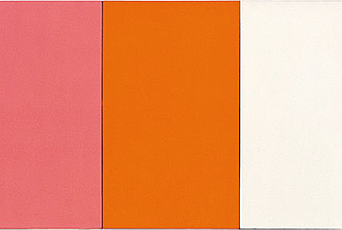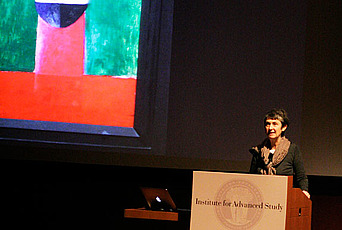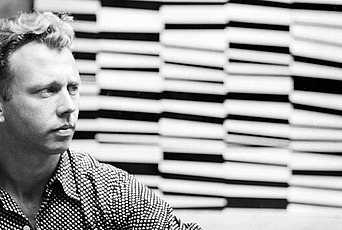One of the final privileges to which members of the Faculty at the Institute accede as they approach retirement, is that of suggesting to their colleagues the names of possible successors. I was the third in the series of art historians, following Erwin Panofsky and Millard Meiss, whose interests focused largely on European art from the Middle Ages through the Renaissance and Baroque. I was acutely aware that there had never been in the School of Historical Studies an appointment devoted primarily to contemporary history. Although it was a dangerous move, given the current tendency of “modernism” to dominate, not to say overwhelm, university art history departments, I felt it was time for a change. And with Kirk Varnedoe, it seemed worth the risk. There was some initial, but soon dispelled, hesitation among the Faculty of the School because he was a “museum man,” rather than a proper academic historian. But Varnedoe had had a very orthodox training— undergraduate at Williams, graduate at Stanford—and his publication record was replete with important, innovative, professionally crafted, and beautifully written scholarly work, wide-ranging within his field. Moreover, throughout his career, he had continued to teach, attracting and rearing many young people to the rigors and unmatched intellectual rewards of our discipline. And after all, the glamour he brought from his long association with the world’s most important institution devoted to modern art (MoMA), as well as his equally legendary personal charisma, could do no real harm to the Institute for Advanced Study!
There has always been one significant reservation about the viability of art history at the Institute. By virtue of a cordial and mutually beneficial agreement with Princeton University we depend very heavily on our privileged access to the University libraries, including Marquand, one of the greatest art libraries in the world. Apart from its comprehensive holdings, a major virtue of Marquand is that it is non-lending. The policy seems, and may be, paradoxical, but it is essential: the books are there when you need them. Art historians by the very nature of their work need to have books physically present at hand, not necessarily (or even primarily) to read them, but in order to compare the images they contain. (Panofsky famously said, he who has the most photographs wins!) When I first came to the Institute I noticed immediately that the visiting Members in art history, unlike their colleagues in other fields, were scarcely to be seen at lunch or teatime, participating in the communal exchange of ideas that is, to my mind, the life-blood of the Institute. They were always working at Marquand Library. The Institute, I discovered, had once actually handed over to Marquand an important (now more valuable than ever) collection of art books—presumably because our Members could make better use of them there, for purposes of comparison. One of my first reactions to the situation was to try to build a basic, general collection of reference material and major periodicals, so as to make it possible for the average Member in our field at least to establish a bibliographic point of departure here, and work at Marquand when, as is still frequently the case, he or she needs more specialized material. The then-Director, Carl Kaysen, was very sympathetic to my appeal and responded with a substantial initial grant of funds toward that goal. Judging now by the lively and regular participation of art historians at lunches, teas, and other events at the Institute, the effort has been largely successful.
Successful, that is, with the notable exception (as regards Western, let us not speak of more exotic fields) of modern art. All academic libraries tend to reflect the interests of the faculty, the smaller the more so, including the Institute’s. And one of the risks of making an appointment in the modern field was that the recipient would be faced with the same kind of situation that had confronted me thirty years before—no books, and members exiled to Marquand Library. The appointment of Kirk Varnedoe proved this risk minimal, since his personal library, which has been given to the Institute, is a veritable treasure trove, unique, of its kind. Some three thousand volumes in all, I suppose that virtually every important publication in his field for the last quarter century is there. The art historical quantity and quality of his library is of course no surprise, considering who Varnedoe was, and the nature of his all-too-brief life’s work. I knew Kirk fairly well for many years, but perusing the list of his holdings for this note in The Institute Letter, I have been astonished by the breadth and depth of his interests beyond his field: only half deal with art, the rest with all manner of themes, from airplanes, children’s and comic books to rugby and motorcycles, but especially philosophy, linguistics, psychology, and the sciences, including anthropology. With this legacy to our library Varnedoe has helped to ensure that modern art will find a firm future and an encompassing vision at the Institute.
Kirk Varnedoe's Pictures of Nothing
While a Professor in the School of Historical Studies at the Institute for Advanced Study from 2002-03, Kirk Varnedoe worked on the A. W. Mellon Lectures he delivered at the National Gallery of Art in Washington, D.C., in the spring of 2003, just months before his death. The lectures, which he gave to overflowing crowds, are reproduced and illustrated in the recently published Pictures of Nothing: Abstract Art Since Pollock (Princeton University Press, 2006).
In the book’s introduction New Yorker critic Adam Gopnik observes that Varnedoe did not have the chance to polish the lectures for publication, but suggests that “their necessarily unfinished nature—their existence as lectures, still-breathing sketches toward a final work, drafts and researches not yet fully closed—may allow readers more room for exactly the kind of open-ended responses, the inventive reinterpretations, the structured but uncoerced freedom to use another’s thought to think again for ourselves, that Kirk Varnedoe thought was at the heart of all creative endeavors.”



